The article below is by Jens Kröger and originally appeared in the Encyclopedia Iranica. Kröger’s article was originally published in print on December 15, 1993 and last updated on November 2, 2011. This article is also accessible in print (Vol. VI, Fasc. 4, pp. 446-448). The version published below has embedded photographs, paintings and accompanying captions that did not appear in the original Encyclopedia Iranica publication/posting.
Readers are also encouraged to support the fundraising campaign for making of the first-ever documentary on the monument of Taq Kasra situated in the Sassanian capital, Ctesiphon – Click Here … and see below video:
=================================
CTESIPHON (Ṭīsfūn), ancient city on the Tigris adjacent to the Hellenistic city of Seleucia, ca. 35 km south of the later site of Baghdad. The origin and meaning of the name is unknown (for the forms, see Honigmann, cols. 1102-03; Markwart, Provincial Capitals, pp. 60-61). In the Greek sources it appears as Ktēsiphôn, in Latin Ctesiphon/Ctesifon from the Greek and T(h)esifon or Et(h)esifon, reproducing local forms. In the Aramaic Talmud (ʾ)qṭyspwn (in Syriac qṭyspwn) occurs. From Iranian texts of the Sasanian period Manichean Parthian tyspwn (or *tysfwn; Henning, pp. 943-44), Pahlavi tyspwn, and Christian Sogdian tyspwn (Sims-Williams, pp. 144, 147-49; Yoshida) are attested. In Arabic texts the name is usually Ṭaysafūn. According to Yāqūt (III, p. 570, IV, p. 446), quoting Ḥamza, the original form was Ṭūsfūn or Tūsfūn, which was arabicized as Ṭaysafūn.
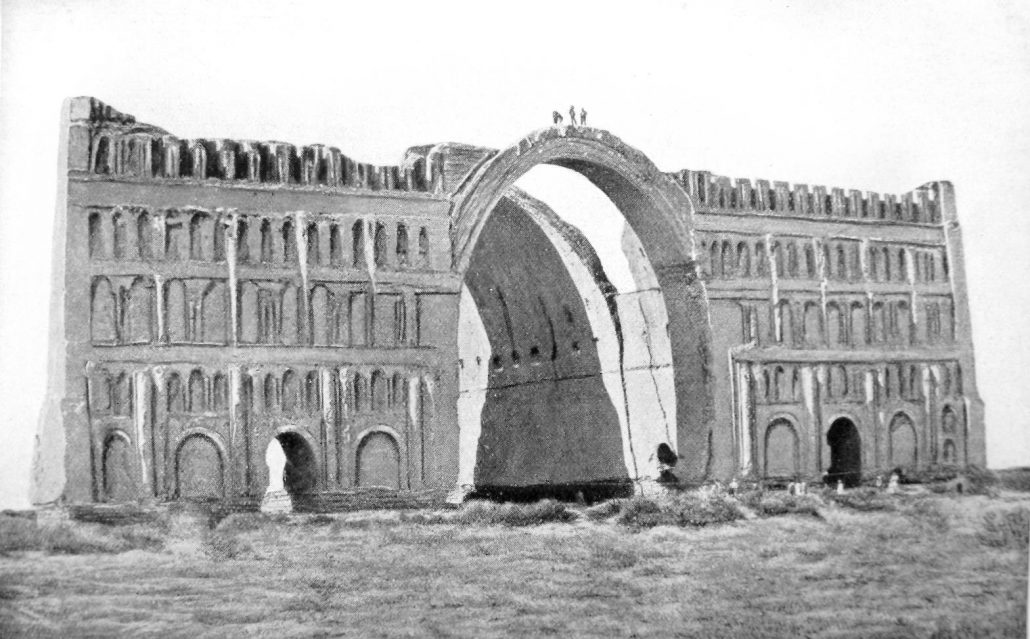
Rare 1864 photograph of the Gateway of Ctesiphon before the right-hand facade of the structure collapsed (Source: Public Domain).
The history of the city has been reported and its ruins extensively described by scholars and travelers through the ages. M. Streck (1900-01, I, pp. 246ff.; 1917, pp. 26ff.) was the first to collect and comment on these writings. Systematic topographical research in the region of Seleucia/Ctesiphon began with Ernst Herzfeld, who worked there from 1903 to 1911 (Sarre and Herzfeld, pp. 46ff.). In 1927 an American expedition led by Leroy Waterman located and excavated Seleucia, on the west bank of the river, near modern Tell ʿOmar. German (1928-29) and German-American (1931-32) teams under Oscar Reuther and Ernst Kühnel respectively excavated sites on both banks and conducted surveys of the area. Since 1964 an Italian expedition under the direction of Giorgio Gullini and Antonio Invernizzi has carried on this work on the west bank. Its findings have helped to clarify the general topography of the site and to provide an initial stratigraphy. Because of the sprawling nature of the city and the complexity of the questions that it poses, however, many points still await further research, and some of the conclusions reached cannot be accepted without doubt (for a differing view, cf. von Gall).
Parthian period
Parthian Ctesiphon has been tentatively located on the east bank of the Tigris opposite Seleucia at a site now bisected by a loop in the Tigris several kilometers north of the Ayvān-e Kesrā, an area that has not yet been systematically explored by archeologists. In the early Parthian period the metropolis of Seleucia/Ctesiphon was the administrative center of Babylonia and also a center for the long-distance trade through the Persian Gulf (cf. Strabo, 16.1.16). When the Arsacids conquered the Mesopotamian lowlands, the capital was transferred to Ctesiphon from Hecatompylos, identified with Šahr-e Qūmes near Dāmḡān (see capital cities i); it thus also became the main terminus for the luxury trade along the Silk Route, as well as through the Persian Gulf. From the time of Mithradates I (ca. 171-38 b.c.e.) until the fall of the Arsacid dynasty in 224 c.e. it was the winter residence of the Arsacid kings (Strabo, 16.1.16; cf. Tacitus, Annals 6.42), though there was a functioning mint in Seleucia throughout the Parthian period (see arsacids iii, p. 540).
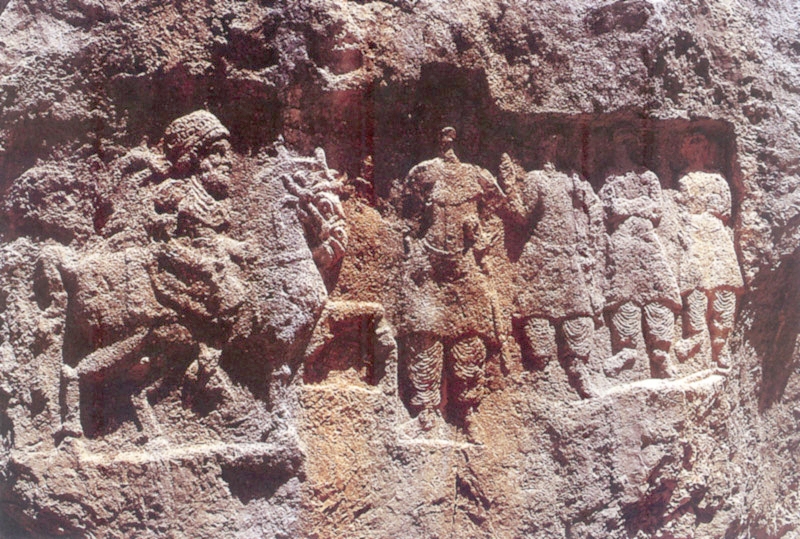
The rock relief of Khong-e Azhdar (خونگ اژدر) in Izeh, Khuzestan (in SW Iran) of Mithradates I (r. 165-132 BCE) (Source: Hamshahrionline).
Modern knowledge about Parthian Ctesiphon is limited and drawn mainly from the accounts of Greek and Roman historians. According to Strabo (16.1.16), the city was founded as a camp for the Parthian armies because the Arsacids did not think it appropriate to admit their troops into the Greek city of Seleucia; Pliny (Natural History 6.122), on the other hand, reported that Ctesiphon was founded to draw the population away from Seleucia. Artabanus II (q.v.; d. 38 c.e.) was said to have been crowned in Ctesiphon in 10 or 11 c.e. (Josephus, Jewish Antiquities 18.48-50). According to Ammianus Marcellinus (23.6.23), the city was enlarged by immigration under Pacorus I around 39 b.c.e. and the same ruler built the city walls. In other sources, however, it is reported that the walls were built somewhat later (Pauly-Wissowa, Suppl., IV, col. 1110). Under Vologeses I (ca. 51-76 or 80 c.e.; for further references, see balāš i) an important new commercial center called Vologesocerta was founded in the region of Seleucia-Ctesiphon, but its identification and precise location are still uncertain.
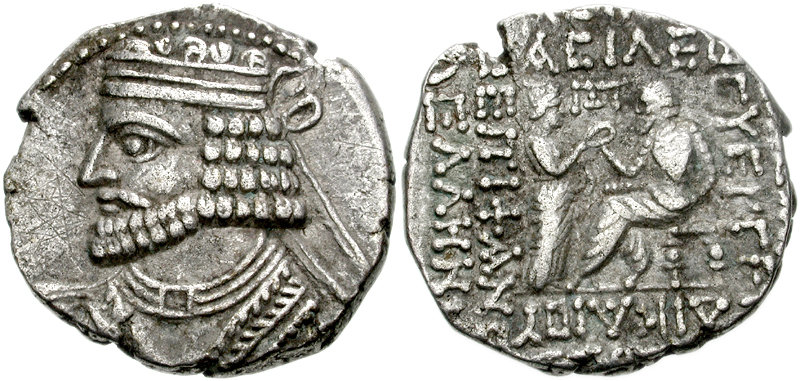
Coin of Vologeses I (Source: Classical Numismatic Group available in Public Domain).
In the following centuries Ctesiphon was repeatedly conquered by the Romans. Trajan captured the city in the spring or summer of 116, receiving the title Parthicus in consequence (Din Cassius, 68.30.3; Arrian, Parthica, frag. 1 in Müller, Fragmenta III, pp. 587, 590); his booty included a daughter of the king Osroes and the golden Parthian throne (Dion Cassius, 68.80.3). In 117 he invested Parthamaspates with the royal Parthian diadem in Ctesiphon. The city was again invaded in December 165, during the reign of Vologeses IV (14892/3; see balāš iv), by the Roman general Avidius Cassius, who demolished the royal palace (Dio Cassius, 71.2.3). In 198, in the reign of Vologeses V (ca. 190 or 193-208), Ctesiphon was conquered for a third time, by Septimius Severus, after hard fighting. The city was sacked, and part of its population was forcibly transported. Following the example of Trajan, Septimius took the title Parthicus Maximus (Dio Cassius, 75.9.2-5; “Severus,” in Historia Augusta 16.12).
After the Romans had withdrawn the city walls were rebuilt. The history of Parthian Ctesiphon ended with the defeat of Artabanus IV in 224 c.e. and the coronation of the Sasanian king Ardašīr I at Ctesiphon in 226.
Sassanian period
Ctesiphon remained the capital and coronation city of the Sasanian empire from the accession of Ardašīr until the conquest by Muslim armies in 16/637. It was at once royal residence, imperial administrative center, and one of the most important cities of the rich agricultural province of Babylonia/Āsōristān, which, with its network of waterways and fertile soils, supported a dense population, especially along the lower Dīāla basin on the east bank of the Tigris, and many large towns (Adams, pp. 69-70). Following ancient custom (see courts and courtiers i), the Sasanian kings used the palace at Ctesiphon only as a winter residence, spending the summers on the cooler highlands of the Persian plateau.
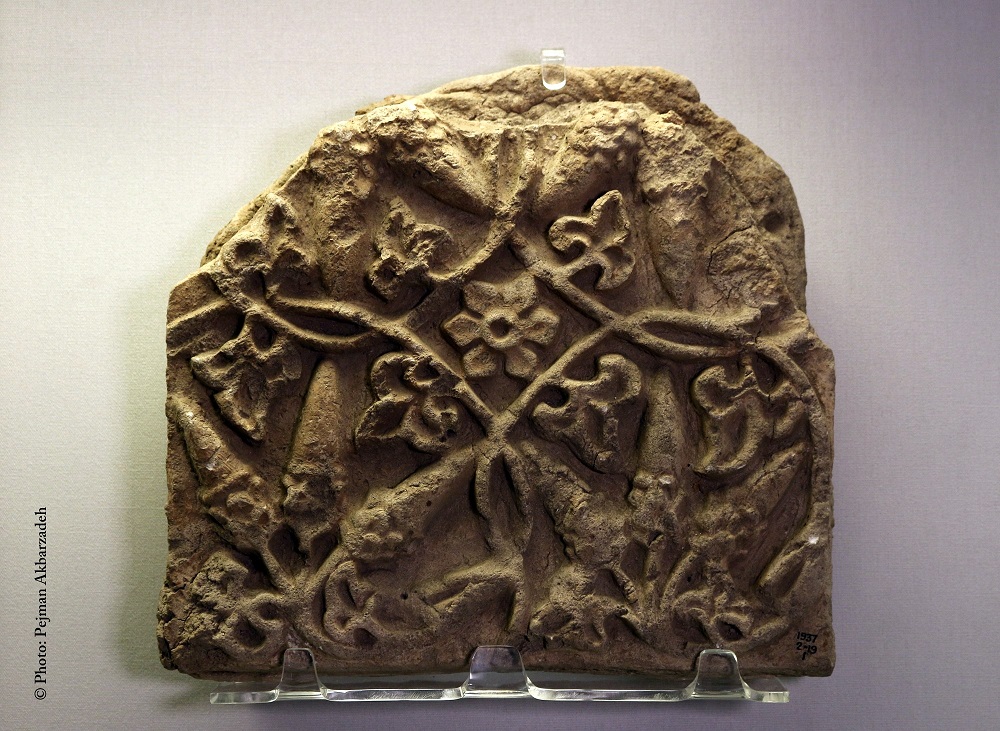
Sassanian stucco from Ctesiphon housed at the British Museum (Photo: Pejman Akbarzadeh).
Although situated in the heartland of the Sasanian empire (del-e Ērānšahr), Ctesiphon and the surrounding area were inhabited mainly by Arameans, Syrians, and Arabs, who spoke Aramaic and were predominantly Christian or Jewish. Both the Jewish exilarch and the Nestorian catholicus resided in the city, and in 410 a Nestorian synod was held there (see Eilers, p. 499; Neusner pp. 917-18, 931). The Zoroastrian Persian ruling class, on the other hand, was in the minority. Curiously, none of the major fire temples was located in Sasanian Mesopotamia, though there were a few smaller ones, apparently including one at Ctesiphon; its exact site has not been identified (Morony, p. 238). In the later Sasanian period it became customary for each king to make a pilgrimage to the venerated fire sanctuary of Ādur Gušnasp at Šīz (Taḵt-e Solaymān) after the coronation ceremonies. The capital was connected by a network of roads with all parts of the empire, and one of the most important routes led to Media, where the summer residence (Hamadān) and the great fire temple were located.
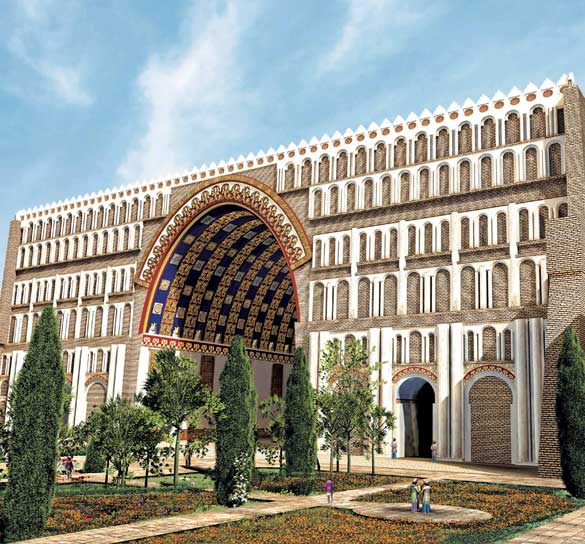
A reconstruction of Ctesiphon as it may have appeared in the 6th and early 7th centuries CE (Source: Sunrisefilmco.com in Pinterest).
From the sources it seems that Parthian Ctesiphon continued to flourish throughout the Sasanian period. A royal palace, the “white palace” (al-qaṣr al-abyaż, abyaż al-Kesrā), as yet unidentified, was still standing there when Mesopotamia was conquered by the Arabs (Ṭabarī, p. 2440; Balāḏorī, Fotūḥ, p. 262). During the Sasanian period Ctesiphon developed into a metropolis, consisting of a series of cities and suburbs along both banks of the Tigris (for a topographical plan, see ayvān-e kesrā). It thus became known as “the cities” (Aram. Māḥōzē, Ar. al-Madāʾen). The process began around 230, when Ardašīr I founded a new city at Ctesiphon; it was called Weh-Ardašīr (see beh-ardašīr) by the Persians, New Seleucia by the Greeks, and Kōḵē by the Syrians. A cathedral church is known to have been located there (Streck, 1917, pp. 42-46). A circular walled city west of the Ayvān-e Kesrā has been identified by the Italians as Weh-Ardašīr (von Gall, pp. 81-84). Excavations have revealed part of the fortifications, artisans’ quarters, and residential areas. A late Sasanian church with a long prayer hall lined by two rows of piers and a tripartite choir was excavated by the German expedition in 1928-29; a fragmentary painted stucco figure found there may represent a saint (Kröger, pp. 47-48, pl. 12/3). Around the middle of the 5th century the course of the Tigris shifted and divided Weh-Ardašīr in two (Venco Ricciardi and Negro Ponzi Mancini, pp. 100-10). The ensuing severe flooding and other hazards must have severely disrupted city life and led to a general decline of this town in the 6th century, when only patches of high ground (e.g., modern Tell Barūda) continued to be inhabited (Venco Ricciardi, 1977, pp. 11-14).
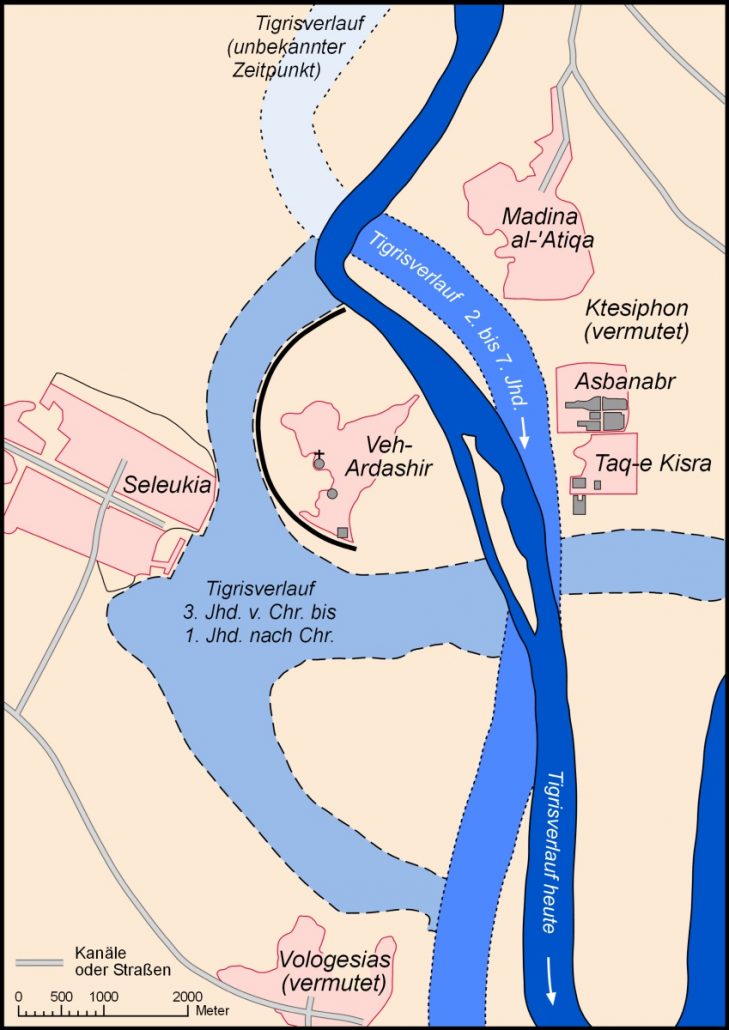
German archeological Map of Seleucia-Ctesiphon during the Sassanian era (Map redrawn by user “Lencer” in Public Domain from original Mesopotamia XL, 2005, 169).
Perhaps owing to these changes or perhaps even earlier Asbānbar, or New Ctesiphon, developed, also on the east bank of the river, south of Parthian Ctesiphon. There stood the Sasanian royal palace, Ayvān-e Kesrā, with its enormous audience hall, still standing today. The German excavations revealed that this structure had been part of a larger complex, probably including a corresponding building on the east side of a large courtyard (Kröger, pp. 13-16). A palace or religious building may have stood on a terrace now called Ḥaram Kesrā or Tell al-Ḏabāʾī about 100 m to the south (Kröger, pp. 40-45). Only the remains of the terrace foundations and stucco fragments of hunting scenes, possibly from a continuous frieze with large busts of kings, were found (Kröger, p. 26). The main decorative features of the palace area were stucco disks decorated on each side with a rosette design. A square terrace known as Tell Ḏahab farther to the southeast yielded similar disks and must thus have had some connection with the palace city. The floors and walls of the palace were decorated with marble, opus sectile, mosaics, and stucco sculptures. It has been suggested that the complex was built by Ḵosrow I Anōšīravān (r. 531-79) to commemorate his conquest of Antioch in Syria in 540 and that it was decorated with mosaics depicting the victory; it is also possible that Byzantine craftsmen sent by the emperor Justinian were employed, which would indicate a probable date before his death in 565. To the north and east of the Ayvān-e Kesrā private houses, probably of the 6th century, have been excavated at the sites of Maʿāreḏ and Omm al-Saʿāter in New Ctesiphon (Kröger, pp. 30-136). Their elaborate ground plans suggest that they belonged to members of the upper classes. Vaulted ayvāns set somewhat apart from the other living quarters contained elaborate ornamental or figural stucco reliefs with religious connotations. Mosaics were not used in these private houses, most of which seem to have been abandoned after the fall of Ctesiphon to the Arabs (Kröger, pp. 50ff.).
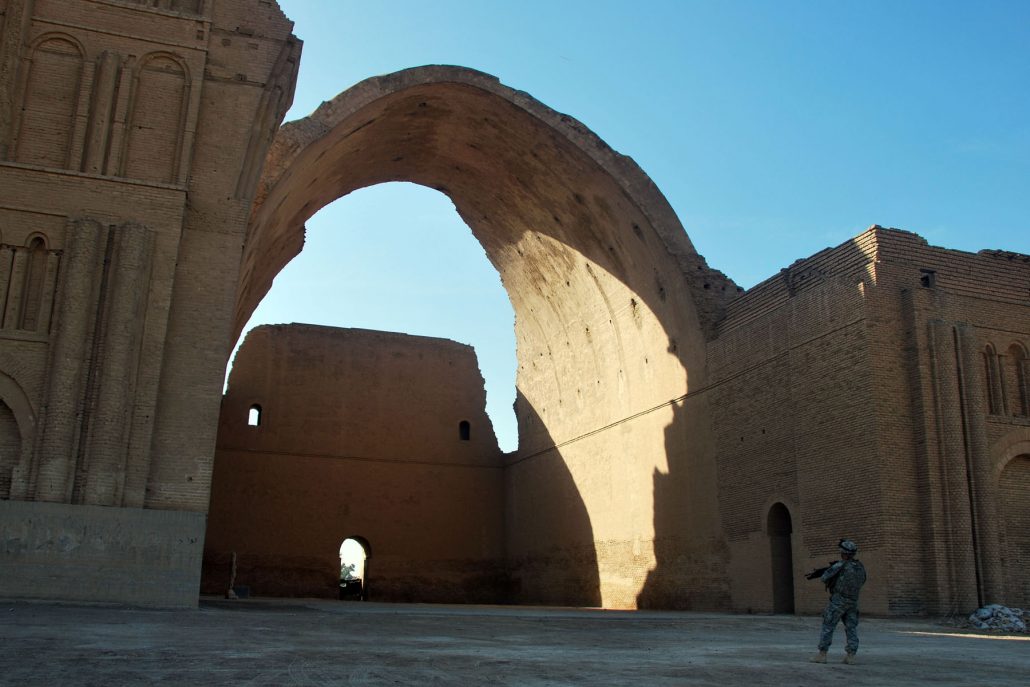
A soldier gazes upon the remains of the archway of Ctesiphon (Source: Sgt. Rebecca Schwab, 2nd Brigade Combat Team, 10th Mountain Division, USD-C in Public Domain).
Another city, still unlocated, was founded at Ctesiphon by Ḵosrow I for the population forcibly transported from Antioch in 540. It was called Weh-Antīōk Ḵosrow/Rūmagān (Ar. Rūmīya) and was modeled on the original plan of Antioch, with its own hippodrome and bath; marble taken by Ḵosrow on his Syrian campaigns is reported to have been used as a building material (Ṭabarī, I, pp. 898, 959; Nöldeke, Geschichte der Perser, pp. 165, 239-40; Dīnavarī, ed. Guirgass, p. 70; Ṯaʿālebī, Ḡorar, pp. 612-13; Masʿūdī, Morūj, ed. Pellat, I, p. 307). In the late 6th century Weh-Antīōk had a population of about 30,000. In the opinion of the German excavators this city may have stood southeast of the Ayvān-e Kesrā in an area now known as Bostān Kesrā, where a rectangular section of an apparent city wall has survived (Kröger, p. 45). It is possible, however, that this section was part of some other wall, perhaps that of a garden. Ḵosrow II Parvēz (r. 590, 591-628) also departed from the established pattern of summering in the Persian highlands and built his royal summer residence at Dastgerd, northeast of Ctesiphon (Same and Herzfeld, pp. 76ff.).
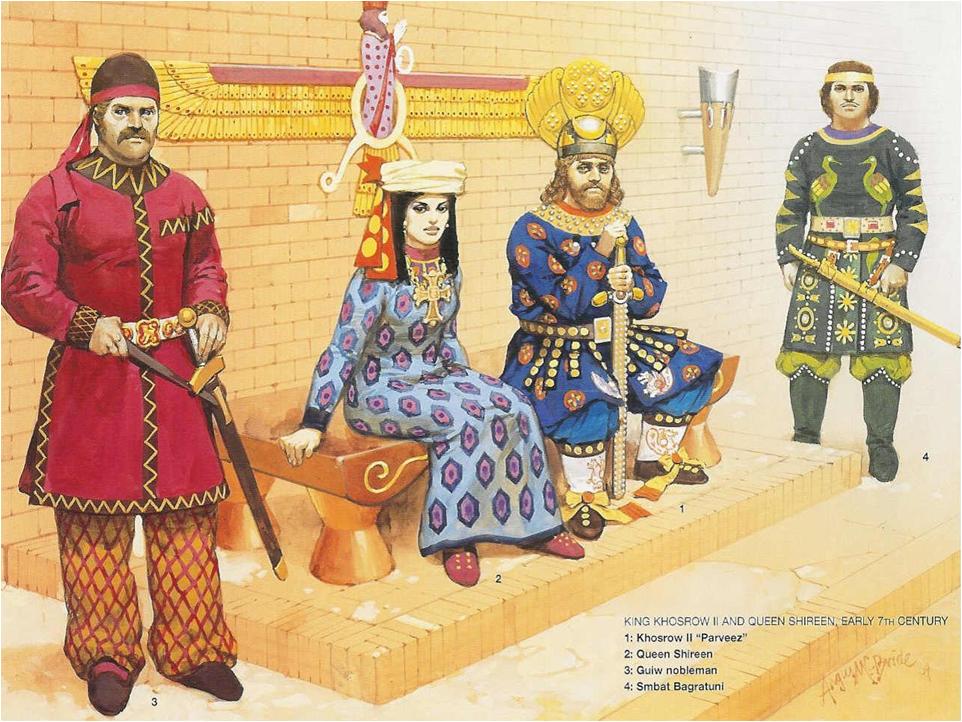
Sassanian court of Khosrow II and his queen Shirin at Ctesiphon (Source: Farrokh, Plate F, p.62, -اسواران ساسانی- Elite Sassanian cavalry, 2005); note the monarch who sits with his ceremonial broadsword. The Sarmatians shared the culture and martial traditions of their Iranian kin, the Parthians and the Sassanians.
In contrast to its history under Parthian rule, Sasanian Ctesiphon was successfully invaded only once before the Muslim conquest, by the Roman emperor Marcus Aurelius Carus in 283. In 363 the emperor Julian passed close to the city on his disastrous retreat after the burning of his fleet on the Euphrates but did not enter it.
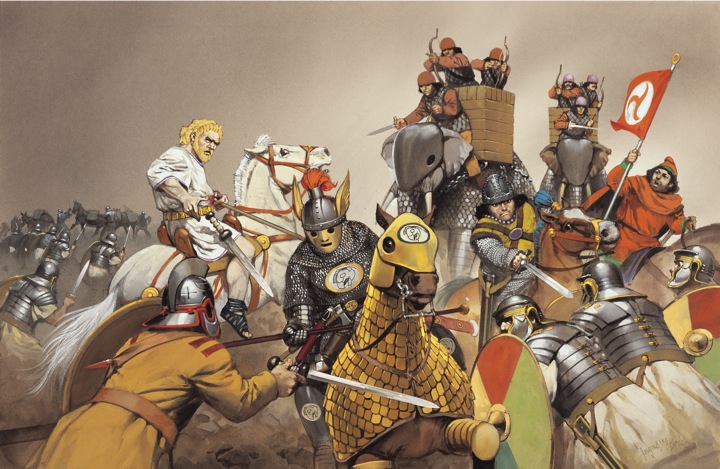
Emperor Julian, who failed to capture Ctesiphon, is killed during his failed invasion of Sassanian Persia in June 26, 363 CE. Above is a recreation of Sassanian Persia’s elite cavalry, the Savaran, as they would have appeared during Julian’s failed invasion. Note the heavily armored Sassanian elite guardsman (Pushtighban) whose lance has pierced a Roman infantryman. Further right is a Savaran officer whose sword is drawn in what is now known as the “Italian grip” but Sassanian in origin. To the far right can be seen a Zoroastrian or Mithraist Magus brandishing a Sassanian era symbol. Also of interest are the armored elephants in the background. Armored elephants were especially prized as their cabs afforded very high elevation over the battlefield, which was ideal for Sassanian archery (Source: Farrokh, Plate D, Elite Sassanian cavalry, 2005).
In 628 the Byzantine emperor Heraclius advanced toward the capital on his campaign against Ḵosrow II. After having destroyed the sanctuary of Šīz/Taḵt-e Solaymān in Azerbaijan and looted Dastgerd he followed the fleeing Ḵosrow II as far as the west bank opposite Ctesiphon. There, in a last effort, Ḵosrow assembled his army and forced Heraclius to retreat (Nöldeke, Geschichte der Perser, pp. 295-96). Only a few years later, however, in March 637 the city was conquered by Muslim troops under Saʿd b. Abī Waqqāṣ (Balāḏorī, Fotūḥ, pp. 262ff.; Dīnavarī, ed. Guirgass, p. 133; Ṭabarī, I, pp. 2431ff.; Yaʿqūbī, Taʾrīḵ II, p. 165; Baḷʿamī, ed. Rowšan, I, pp. 464-67). The Sasanian royal family, the nobles, and the army fled, and the invading army seized fabulous amounts of booty from the royal treasury, including the celebrated garden carpet called bahār-e Kesrā.
Bibliography
R. M. Adams, Land behind Baghdad, Chicago, 1965.
S. A. al-ʿAli, “Al-Madaʾin and Its Surrounding Area in Arabic Literary Sources,” Mesopotamia 3-4, 1968-69, pp. 417-39.
N. C. Debevoise, A Political History of Parthia, Chicago, 1938.
W. Eilers, “Iran and Mesopotamia,” in Camb. Hist. Iran III/1, pp. 481-504.
J. M. Fiey, “Topography of al-Madaʾin,” Sumer 23, 1967, pp. 3-36.
H. von Gall, review of Mesopotamia 1, 1966, in Kunst des Orients 6, 1969, pp. 80-85.
G. Gullini, “Problems of an Excavation in Northern Babylonia,” Mesopotamia 1, 1966, pp. 7-38.
W. B. Henning, “Mani’s Last Journey,” BSOAS 10/4, 1942, pp. 911-53; repr. in Selected Papers II, Acta Iranica 15, Tehran and Liège, 1977, pp. 81-93.
A. Invernizzi, “Ten Years’ Research in the al-Madaʾin Area, Seleucia and Ctesiphon,” Sumer 32, 1976, pp. 167-75.
J. Kröger, Sasanidischer Stuckdekor, Mainz, 1982.
E. Kühnel, Die Ausgrabungen der zweiten Ktesiphon-Expedition (Winter 1931/2), Berlin, 1933.
O. Kurz, “The Date of the Taq i Kisra,” JRAS, 1941, pp. 37-41.
A. Maricq, “Vologésias, l’emporium de Ctésiphon,” Syria 36, 1959, pp. 264-76; repr. in Classica et Orientalia, Paris, 1965, pp. 113-25.
M. G. Morony, Iraq after the Muslim Conquest, Princeton, N.J., 1984.
M. M. Negro Ponzi and M. C. Cavallero, “The Excavations at Choche,” Mesopotamia 2, 1967, pp. 41-56.
J. Neusner, “Jews in Iran,” in Camb. Hist. Iran III/2, pp. 109-23.
O. Reuther, Die Ausgrabungen der Deutschen
Ktesiphon-Expedition im Winter 1928/29, Wittenberg, 1930.
F. Sarre and E. Herzfeld, Archäologische Reise im Euphrat- und Tigrisgebiet II, Berlin, 1920.
K. Schippmann, Grundzüge der parthischen Geschichte, Darmstadt, 1980.
N. Sims-Williams, The Christian Sogdian Manuscripts C2, Berliner Turfantexte 12, Berlin, 1985.
M. Streck, Die alte Landschaft Babylonien nach den arabischen Geographen, 2 vols., Leiden, 1900-01.
Idem, “Seleucia und Ktesiphon,” Der Alte Orient 16, 1917, pp. 1-64.
R. Venco Ricciardi, “The Excavations at Choche,” Mesopotamia 3-4, 1968-69, pp. 57-68.
Idem, “Trial Trench at Tell Baruda,” Mesopotamia 12, 1977, pp. 11-14.
Idem and M. M. Negro Ponzi Mancini, La terra tra i due fiumi, Turin, 1985.
L. Waterman, Preliminary Report upon the Excavations at Tel Umar, Iraq, Ann Arbor, Mich., 1931-33.
Y. Yoshida, review of The Christian Sogdian Manuscripts C2, BSOAS 51/1, 1988, pp. 146-48.



